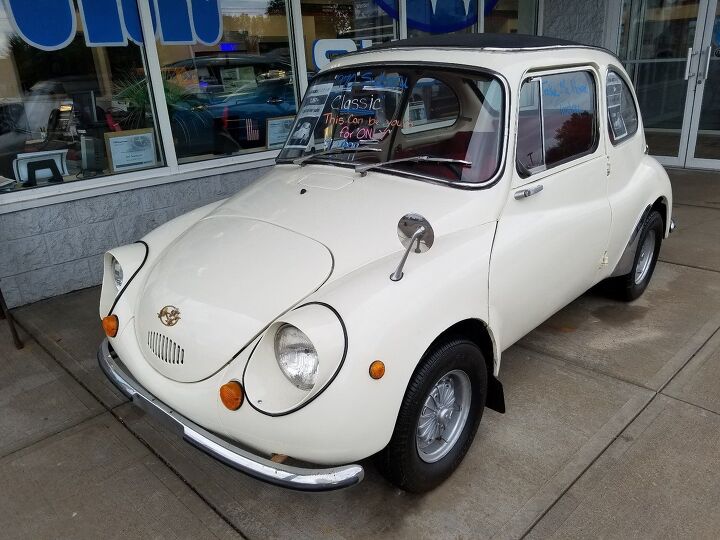Rare Rides: A 1970 Subaru 360, America's First Subaru Experience

Subaru is presently in the midst of a sales boom. As Tim Cain pointed out last week in his Subaru Question of the Day, the company has found fairly recent success selling what are essentially three different variations of the exact same all-wheel drive crossover formula. Customers just go into the dealer and say whether they’d like the extra small, small, or medium-sized version. But long before today’s crossovers, and even the quirky Leone and XT which preceded them, there was Subaru’s genesis.
And the little white Kei car you see before you is the very genesis of which we speak.
It all started back in the mid-1960s with a man named Malcolm Bricklin. An entrepreneur who’d later create his own car (the SV-1), Bricklin’s first foray into automobiles was with Subaru.
At the time, Bricklin was looking for a supplier of scooters for a rental idea he had, where gas stations would double as rental offices. Traveling to Fuji Heavy Industries in Japan, Bricklin’s initial intention was to check out their Rabbit scooter. However, Fuji was moving away from scooter production (the Fuji Rabbit lived to just 1968), and was honing in on cars. In comes the 360.
The 360 could avoid expensive federalization (including crash testing) thanks to a curb of weight less than 1,000 pounds, and its tiny engine promised up to 60 miles per gallon. Bricklin negotiated an exclusive importation contract with Fuji and formed Subaru of America, importing the first 360s in 1968.
Starting life back in 1958, the 360 became Subaru’s second passenger vehicle after the 1500P1 ended production in 1955. The entire body is just 117.7 inches long, with a width of 51.2 inches. The engine is located in the rear, and it’s a 423 cc two-cylinder. Basically, a motorcycle engine. The three-speed manual transmission helped get the 360 to 60 miles per hour in an incredibly leisurely 37 seconds, making use of all 36 horsepower.
Ultimately, the 360 was not in line with American driving tastes in regards to space and power. A big nail in its coffin came in 1969, when Consumer Reports labeled it “Not Acceptable” because of power and safety concerns. The 360 existed on dealer lots for just three years in America, being succeeded by the FF-1 Star starting in 1970.
Our example today was found on eBay in a listing that concluded last week. Despite bids up to $6,199, the listing did not meet the reserve, meaning the dealer should still have it available. It’s a most interesting start to a car company that’s a household name half a century later.
[Images via seller]

Interested in lots of cars and their various historical contexts. Started writing articles for TTAC in late 2016, when my first posts were QOTDs. From there I started a few new series like Rare Rides, Buy/Drive/Burn, Abandoned History, and most recently Rare Rides Icons. Operating from a home base in Cincinnati, Ohio, a relative auto journalist dead zone. Many of my articles are prompted by something I'll see on social media that sparks my interest and causes me to research. Finding articles and information from the early days of the internet and beyond that covers the little details lost to time: trim packages, color and wheel choices, interior fabrics. Beyond those, I'm fascinated by automotive industry experiments, both failures and successes. Lately I've taken an interest in AI, and generating "what if" type images for car models long dead. Reincarnating a modern Toyota Paseo, Lincoln Mark IX, or Isuzu Trooper through a text prompt is fun. Fun to post them on Twitter too, and watch people overreact. To that end, the social media I use most is Twitter, @CoreyLewis86. I also contribute pieces for Forbes Wheels and Forbes Home.
More by Corey Lewis
Latest Car Reviews
Read moreLatest Product Reviews
Read moreRecent Comments
- Golden2husky The biggest hurdle for us would be the lack of a good charging network for road tripping as we are at the point in our lives that we will be traveling quite a bit. I'd rather pay more for longer range so the cheaper models would probably not make the cut. Improve the charging infrastructure and I'm certainly going to give one a try. This is more important that a lowish entry price IMHO.
- Add Lightness I have nothing against paying more to get quality (think Toyota vs Chryco) but hate all the silly, non-mandated 'stuff' that automakers load onto cars based on what non-gearhead focus groups tell them they need to have in a car. I blame focus groups for automatic everything and double drivetrains (AWD) that really never gets used 98% of the time. The other 2% of the time, one goes looking for a place to need it to rationanalize the purchase.
- Ger65691276 I would never buy an electric car never in my lifetime I will gas is my way of going electric is not green email
- GregLocock Not as my primary vehicle no, although like all the rich people who are currently subsidised by poor people, I'd buy one as a runabout for town.
- Jalop1991 is this anything like a cheap high end German car?







































Comments
Join the conversation
I remember going to the dealer in Elmhurst, IL to look at these in 1970 or so. I actually managed to twist my teenage 6+ foot frame into the back seat. When I put my feet on the floor, the metal flexed about 2". I also have a recollection of seeing a photo of a herd of these used at a go kart track at some point.
I was in the Army in 1968 stationed in Oklahoma. Thousand of these were parked at the old air base outside of Oklahoma City. Like gumdrops in bright colors. I think these were the ones with bad defrosters which went back to be crushed.